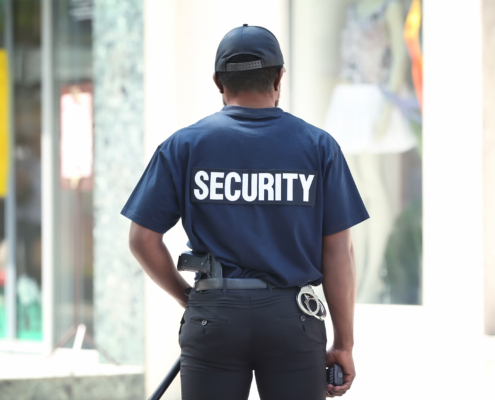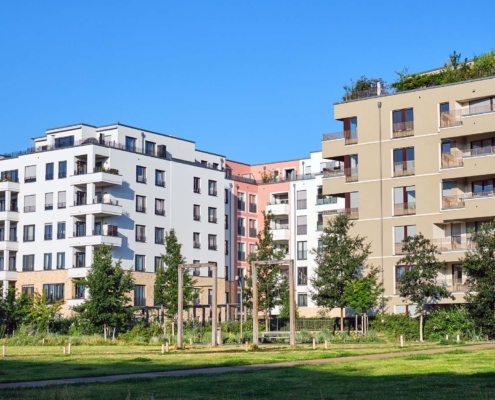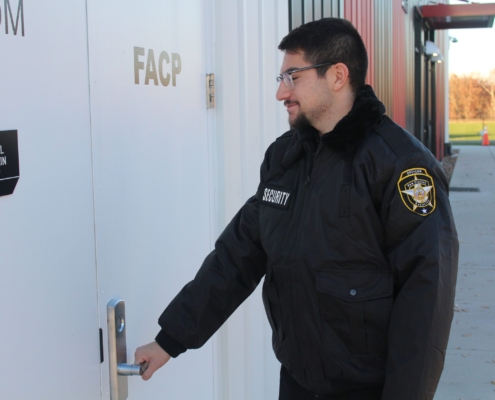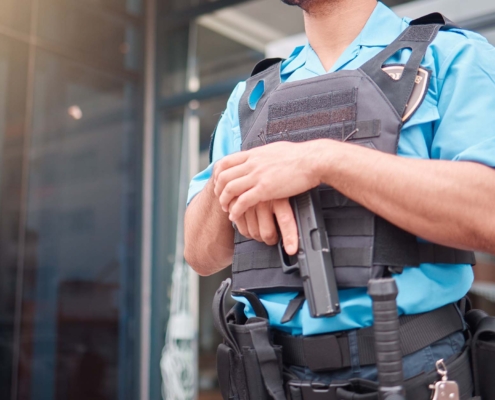Security for Data Centers: Why Armed Security Is Crucial for Mission-Critical Facilities
Here’s how armed security closes physical gaps, protects red zones, and works with your SOC to keep operations secure and online.
Here’s how armed security closes physical gaps, protects red zones, and works with your SOC to keep operations secure and online.
A determined actor who reaches a rack can bypass world-class defenses in minutes: pull a drive, insert a rogue device, cut a cable, or kill cooling. That’s why mature programs treat doors, docks, and drive bays like another attack surface. Armed officers help at three points:
The result is fewer hands near hardware and fewer chances to convert a cyber alert into operational downtime.
Data centers succeed when they enforce discipline at every threshold. Entry isn’t just a single door; it’s a layered journey through perimeter gates, reception, mantraps, and two-factor checkpoints. Guards enforce a “no tailgating” culture and verify that each credential matches both an ID and a valid work order.
Rather than relying solely on lists, armed officers build rhythm into these checks. A contractor might arrive for a routine fiber pull. Before they step into the white space, an officer confirms their badge, cross-references their ticket, and inspects their tools. That brief process blocks unauthorized access without slowing the operation.
These controls slow down the attacker without slowing down authorized work.
Not all spaces are equal. Define your zones clearly:
Armed officers enforce two-person rules in red space, escort movement, and restrict devices (no cameras, no RF where required). Every entry, exit, and exception is logged in a way that’s ready for audits. When a door alarm, camera analytic, or human report indicates tampering, guards move first to contain and notify, then hand off to responders with a clean record of what happened.
Most data centers operate a Security Operations Center that monitors alarms, sensors, and access logs. But a blinking screen can’t stop an intruder. That’s where armed guards step in, turning alerts into action.
Instead of waiting for IT to review logs when an issue occurs, security for your data center can immediately verify the door, contain the area, and radio for escalation. Clear runbooks dictate who locks down adjacent corridors, who calls facilities, and who contacts law enforcement. This fast loop reduces the mean time to respond from minutes to seconds.
Some periods bring elevated risks. Construction phases, maintenance windows, and after-hours access are prime examples. Even regular activity, like equipment migrations, opens temporary vulnerabilities.
Armed patrols adapt by tightening procedures: limiting badge access to scheduled windows, running random checks, and escorting third-party vendors through sensitive rooms. These adjustments prevent opportunistic intrusions at times when controls are naturally looser.
Data doesn’t die when drives are pulled, it lingers until destruction. That’s why armed escorts oversee the entire chain of custody. Drives are serialized, logged, and transported under guard. Officers witness shredding or degaussing, confirm reconciled serials, and lock certificates into compliance files.
This process may feel redundant, but it closes one of the biggest physical loopholes: unauthorized cloning or covert imaging before destruction. Armed supervision ensures the media leaves the facility truly inert.
Loading docks are often overlooked, yet they’re the most porous entry point in many facilities. Without oversight, a mislabeled box or swapped pallet could compromise equipment or expose sensitive components.
Armed officers secure docks by checking seals, separating inbound and outbound shipments, and monitoring couriers. Their role isn’t to slow down logistics, but to prevent costly mistakes, like a high-value server leaving under the wrong paperwork or copper wiring disappearing during construction.
Not every post needs to be visibly armed. Facilities often mix approaches: overt deterrence at perimeters and docks, discreet coverage in client-facing spaces. Choosing the right posture depends on tier, tenant mix, incident history, and geography. Armed guards are deployed where seconds matter most, while unarmed staff may support in lower-risk zones.
This balance keeps the site professional and welcoming, without sacrificing security in critical areas.
Need physical controls that match your cyber stack?
Rolling out security for your data center doesn’t have to drag on. Most providers start with a site survey, mapping out red zones, amber spaces, and green areas. From there, clear post orders are written, drills are scheduled, and reporting systems are aligned with audit standards like SOC 2 and ISO 27001.
The value shows up quickly: fewer successful tailgating attempts, faster alarm acknowledgments, and tighter audit results. Small improvements, like better escort routes or quicker radio protocols, compound into stronger overall resilience.
If you’re interested in professional security for your data center, here’s what to look for:
Cybersecurity alone can’t guarantee uptime. Attackers still test doors, docks, and drive bays because code doesn’t control those spaces. Armed physical security for a data center fills that gap, deterring attempts and acting on alerts before they snowball.
If your facility hosts mission-critical workloads, consider a plan that protects doors and drives as carefully as firewalls. IronWatch can help design a program that blends armed access control, red-zone coverage, and fast SOC-to-guard response. Let’s map out a security solution that protects both your data and your bottom line.
 https://www.ironwatchsecurity.com/wp-content/uploads/2025/11/Male-security-guard-outdoors.jpg
1250
2000
Abstrakt Marketing
/wp-content/uploads/2025/01/fulllogo_transparent-color.png
Abstrakt Marketing2025-11-17 10:09:172025-12-03 10:26:21Armed Security Regulations and Compliance: What You Need to Know
https://www.ironwatchsecurity.com/wp-content/uploads/2025/11/Male-security-guard-outdoors.jpg
1250
2000
Abstrakt Marketing
/wp-content/uploads/2025/01/fulllogo_transparent-color.png
Abstrakt Marketing2025-11-17 10:09:172025-12-03 10:26:21Armed Security Regulations and Compliance: What You Need to Know https://www.ironwatchsecurity.com/wp-content/uploads/2025/10/Multi-family-housing-complex.jpg
1250
2000
Abstrakt Marketing
/wp-content/uploads/2025/01/fulllogo_transparent-color.png
Abstrakt Marketing2025-10-24 12:46:242025-12-03 10:26:21The Importance of Armed Security in Arlington, VA
https://www.ironwatchsecurity.com/wp-content/uploads/2025/10/Multi-family-housing-complex.jpg
1250
2000
Abstrakt Marketing
/wp-content/uploads/2025/01/fulllogo_transparent-color.png
Abstrakt Marketing2025-10-24 12:46:242025-12-03 10:26:21The Importance of Armed Security in Arlington, VA https://www.ironwatchsecurity.com/wp-content/uploads/2025/09/African-American-security-guard-in-building.jpg
1250
2000
Abstrakt Marketing
/wp-content/uploads/2025/01/fulllogo_transparent-color.png
Abstrakt Marketing2025-09-24 12:49:272025-12-03 10:26:22The Role of Armed Security in Executive Protection Security
https://www.ironwatchsecurity.com/wp-content/uploads/2025/09/African-American-security-guard-in-building.jpg
1250
2000
Abstrakt Marketing
/wp-content/uploads/2025/01/fulllogo_transparent-color.png
Abstrakt Marketing2025-09-24 12:49:272025-12-03 10:26:22The Role of Armed Security in Executive Protection Security https://www.ironwatchsecurity.com/wp-content/uploads/2025/03/IMG_0728-scaled-1.jpg
1707
2560
Abstrakt Marketing
/wp-content/uploads/2025/01/fulllogo_transparent-color.png
Abstrakt Marketing2025-08-19 08:40:552025-12-03 10:26:23What You Need to Know Before Hiring Security for a Private Event
https://www.ironwatchsecurity.com/wp-content/uploads/2025/03/IMG_0728-scaled-1.jpg
1707
2560
Abstrakt Marketing
/wp-content/uploads/2025/01/fulllogo_transparent-color.png
Abstrakt Marketing2025-08-19 08:40:552025-12-03 10:26:23What You Need to Know Before Hiring Security for a Private Event https://www.ironwatchsecurity.com/wp-content/uploads/2025/08/retail-security-officer-wearing-uniform-standing-at-clothes-shop.jpg
1250
2000
Abstrakt Marketing
/wp-content/uploads/2025/01/fulllogo_transparent-color.png
Abstrakt Marketing2025-08-19 08:28:372025-12-03 10:26:23Retail Security Services: Why They’re a Must for 2026
https://www.ironwatchsecurity.com/wp-content/uploads/2025/08/retail-security-officer-wearing-uniform-standing-at-clothes-shop.jpg
1250
2000
Abstrakt Marketing
/wp-content/uploads/2025/01/fulllogo_transparent-color.png
Abstrakt Marketing2025-08-19 08:28:372025-12-03 10:26:23Retail Security Services: Why They’re a Must for 2026 https://www.ironwatchsecurity.com/wp-content/uploads/2025/02/ironwatch-guards-discussing.jpg
994
1024
Abstrakt Marketing
/wp-content/uploads/2025/01/fulllogo_transparent-color.png
Abstrakt Marketing2025-08-19 08:22:512025-12-03 10:26:24The Role Armed Guards Play in Workplace Violence Prevention
https://www.ironwatchsecurity.com/wp-content/uploads/2025/02/ironwatch-guards-discussing.jpg
994
1024
Abstrakt Marketing
/wp-content/uploads/2025/01/fulllogo_transparent-color.png
Abstrakt Marketing2025-08-19 08:22:512025-12-03 10:26:24The Role Armed Guards Play in Workplace Violence Prevention https://www.ironwatchsecurity.com/wp-content/uploads/2025/08/security-guard-on-radio.jpg
1250
2000
Abstrakt Marketing
/wp-content/uploads/2025/01/fulllogo_transparent-color.png
Abstrakt Marketing2025-08-06 08:54:312025-12-03 10:26:24The Role of Situational Awareness in Security
https://www.ironwatchsecurity.com/wp-content/uploads/2025/08/security-guard-on-radio.jpg
1250
2000
Abstrakt Marketing
/wp-content/uploads/2025/01/fulllogo_transparent-color.png
Abstrakt Marketing2025-08-06 08:54:312025-12-03 10:26:24The Role of Situational Awareness in Security https://www.ironwatchsecurity.com/wp-content/uploads/2025/08/Security-guard-walking-with-firearm-in-holster.jpg
1250
2000
Abstrakt Marketing
/wp-content/uploads/2025/01/fulllogo_transparent-color.png
Abstrakt Marketing2025-08-06 08:41:152025-12-03 10:26:25What to Expect During an Armed Security Patrol
https://www.ironwatchsecurity.com/wp-content/uploads/2025/08/Security-guard-walking-with-firearm-in-holster.jpg
1250
2000
Abstrakt Marketing
/wp-content/uploads/2025/01/fulllogo_transparent-color.png
Abstrakt Marketing2025-08-06 08:41:152025-12-03 10:26:25What to Expect During an Armed Security Patrol https://www.ironwatchsecurity.com/wp-content/uploads/2025/08/Armed-security-guard.jpg
1250
2000
Abstrakt Marketing
/wp-content/uploads/2025/01/fulllogo_transparent-color.png
Abstrakt Marketing2025-08-06 08:26:042025-12-03 10:26:25Armed Security Requirements: When Your Business Is Legally Required to Have Armed Professionals
https://www.ironwatchsecurity.com/wp-content/uploads/2025/08/Armed-security-guard.jpg
1250
2000
Abstrakt Marketing
/wp-content/uploads/2025/01/fulllogo_transparent-color.png
Abstrakt Marketing2025-08-06 08:26:042025-12-03 10:26:25Armed Security Requirements: When Your Business Is Legally Required to Have Armed Professionals
 The Importance of Armed Security in Arlington, VA
The Importance of Armed Security in Arlington, VAThis site uses cookies. By continuing to browse the site, you are agreeing to our use of cookies.
AcceptLearn moreWe may request cookies to be set on your device. We use cookies to let us know when you visit our websites, how you interact with us, to enrich your user experience, and to customize your relationship with our website.
Click on the different category headings to find out more. You can also change some of your preferences. Note that blocking some types of cookies may impact your experience on our websites and the services we are able to offer.
These cookies are strictly necessary to provide you with services available through our website and to use some of its features.
Because these cookies are strictly necessary to deliver the website, refusing them will have impact how our site functions. You always can block or delete cookies by changing your browser settings and force blocking all cookies on this website. But this will always prompt you to accept/refuse cookies when revisiting our site.
We fully respect if you want to refuse cookies but to avoid asking you again and again kindly allow us to store a cookie for that. You are free to opt out any time or opt in for other cookies to get a better experience. If you refuse cookies we will remove all set cookies in our domain.
We provide you with a list of stored cookies on your computer in our domain so you can check what we stored. Due to security reasons we are not able to show or modify cookies from other domains. You can check these in your browser security settings.
We also use different external services like Google Webfonts, Google Maps, and external Video providers. Since these providers may collect personal data like your IP address we allow you to block them here. Please be aware that this might heavily reduce the functionality and appearance of our site. Changes will take effect once you reload the page.
Google Webfont Settings:
Google Map Settings:
Google reCaptcha Settings:
Vimeo and Youtube video embeds:
